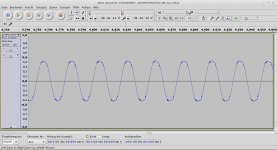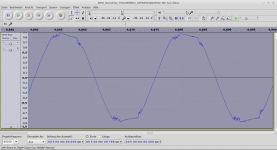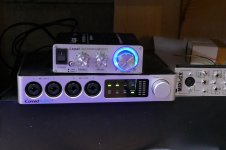This is one thing that is very nicely covered in Merlin Blencowe's preamp design book. In the section on small-signal pentodes, he makes it very clear that it is the screen grid voltage that controls the current through a pentode, and not the anode voltage.Yep, "be kind to your screens and you can punish your plates"
This was very useful to me when I first read it, because I was coming from the world of semiconductors, and there really is no functional equivalent to a screen grid in any semiconductor device that I know of.
-Gnobuddy
You could say this about playing the blues too, but it's still being played.Anything that can be discussed about tube amps has been discussed endlessly, there is nothing new on the planet.
I fell in love with tubes when I was quite young, I liked the tube glow, the llook, the sound and the smell of old radios. Eventually I learned to repair basic faults.
Later I fell I love with the guitar, and at some point I realized what a good team the three of us could make...
Rock'n'Roll and electric Blues were invented with the gear available at that time, and that's the reason why it sounded like it did. Tubes are definitely the sound of my music.
I do not make a living from music, so I have not that pragmatic approach.
Using transistors or even highly sophisticated algorithms to simulate the tonal properties of technology from the stone age does not really make it feel real to me.
Just as my relation with my guitars went through many ups and downs (and will go through many more), it did and does with my amps. They never sound the same on two days. They sound differently when hot. Tubes wear out and it takes me ages to get used to new ones. Plus a thousand of other things. I admit, they drive me crazy sometimes. But it keeps the challenge alive. They are musical instruments, with all their imperfections.
No, I would not say that playing a specific style like blues is bound to a specific technical hardware.You could say this about playing the blues too, but it's still being played.
.
btw, don't get my wrong - I always earned my living from hardware design, not by making music.
And concerning the sound - I know this feeling very well:
One day, the sound is great, the other day it is boring.
The same guitar, same amp, same player.
But in a different mood.
I think that there is actually a fascinating third possibility: mixing solid-state and "vacuum state" components in the same circuit. When done thoughtfully, I think it can allow us to improve on both traditional tube amps and traditional solid-state amps.Anything that can be discussed about tube amps has been discussed endlessly, there is nothing new on the planet.
It is time for some discussion about SS-guitar amps.
A small example: it seems to me a cathodyne phase splitter is a waste of a triode. Because of the heavy local negative feedback, there is no musically attractive distortion from a cathodyne (it's too little to hear). When it does distort, it does very bad things (Merlin Blencowe has a section on this in his book). And the large saturation voltage of a high Ra triode severely limits the maximum output signal available before clipping.
So a cathodyne is a perfect candidate for replacing with a modern high-voltage MOSFET. There is no audible change in sound, a triode is saved for use somewhere more musically interesting, and the MOSFET is better in every way - more drive signal before clip, no heater power or valve socket needed, cheaper, etc. (There is one condition, you have to put in appropriate attenuation ahead of the "Source-O-Dyne" to make sure it never clips; we don't ever want to hear harsh MOSFET clipping!)
Neither Leo nor Jim (nor the RCA engineers who created the circuits they borrowed) ever used a MOSFET in their amps - they couldn't have, because there were no MOSFETs back then.
Another intriguing possibility is to use a powerful solid-state class D power amplifier module, with an all-valve preamp designed to sound as rich as a complete all-valve guitar amplifier (but only producing milliwatts of output power, to drive the SS module). Kinda like the valve amp -> line out -> big P.A. system approach, but this time, building the solid-state P.A. system into your combo amp.
This would also use the best characteristics of both SS and valve devices, so you'd combine musical valve distortion, and efficient, economical, lightweight solid-state power amplification.
It's absolutely amazing how much clean audio power you can get from a small, light, class D module for surprisingly little money now. Like the recent thread about the 600 watt (!!) TI module for well under $100 US.
Taking this sort of hybrid approach, I think there is the possibility of creating new guitar amp designs with less input noise than all-valve designs, with rich valve distortion, smaller, lighter, cooler-running, and where every active device (solid-state or vacuum-state) is used for its greatest strengths, with its weaknesses minimized.
-Gnobuddy
Very true, there are even days when David Gilmour's guitar sounds don't cause rainbows and angels to appear inside my head!But in a different mood.
-Gnobuddy
Over the years I designed numerous Class-D-amp pcbs, including TPA3255, TPA3100, TPA3118, TPA3251 and TPA3255. My motivation focused on building 12V battery powered small combos. One of the first things to learn was that Class-D-clipping distortion is real crackling nasty sound, unacceptable if you push the amp into the limits (i.e. not for guitar players )
)
Yesterday I had to check some old musicbox speaker and I connected it to one of my hifi-TPA3255 boards that lay around. Then I applied a low frequency sine wave around 40Hz and turned up the volume until a crackling sound like some loose voice coil windings came up. After some investigation it became evident that the speaker was fine, but the amp was just reaching its clipping point. The transisition from linear to clipped is noisy, and in case of a low frequency test signal that noise is inevitably audible.
This sound has been captured using my soundcard and as a result I append an audio-snippet of that recording.
Feeding the audio into audicity shows the distortion and the noise during transition.
Yesterday I had to check some old musicbox speaker and I connected it to one of my hifi-TPA3255 boards that lay around. Then I applied a low frequency sine wave around 40Hz and turned up the volume until a crackling sound like some loose voice coil windings came up. After some investigation it became evident that the speaker was fine, but the amp was just reaching its clipping point. The transisition from linear to clipped is noisy, and in case of a low frequency test signal that noise is inevitably audible.
This sound has been captured using my soundcard and as a result I append an audio-snippet of that recording.
Feeding the audio into audicity shows the distortion and the noise during transition.
felt that that post (and subsequent related ones) should be split off and moved into a new thread. Which, to my surprise, was called "Tube Emulation & EQ".
Solid State anything became a very touchy subject in that thread. It has a lot to do with how the thread got started. A person boasted that he had designed the absolute best "tube guitar amp kit" ever made for a certain price point, and made a statement that nobody here could do it better. I replied with two words "wanna bet." A third party then created the HBAC and set forth some rules. There was a contest to see who could design and build the "best" TUBE guitar amp for less than $100 in parts cost. Unfortunately the words "best" and "tube" were not fully defined up front, and as much as a third of the posts in that thread were arguments, insults, and general nastiness about what was allowed in a "tube" guitar amp. It seems that the originator used solid state diodes in his power supply, so that was OK, but no other forms of silicon were allowed, even though the challenge starter agreed to the use of mosfets.
Since your design went totally against the grain of the originator, that's probably why it got moved.
So a cathodyne is a perfect candidate for replacing with a modern high-voltage MOSFET.
That was the item that started a storm somewhere in the early days of the thread. Some of those posts were zapped and therefore no longer part of the thread. The little 4 tube guitar amp from that thread is still the only working guitar amp that I have right now. It suits me just fine. The fetodyne got pulled in favor of a self split output stage that just sucked, and was the first thing that I put back when I rebuilt the amp for usefulness, not rules compliance. I had been working on the mosfet saturator in Florida before the move, so it was number 2 on the list. So the amp today has 4 tubes and 2 LND150's. Is it still a tube amp? I really don't care......it ROCKS.
I wondered when you would work your magic on some 6V6s.
My first "guitar amp" was a Magnavox monophonic HiFi that used a 12AX7, a 5Y3 and a pair of 6V6GT's. The first DIY guitar amp I ever made was a Champ 5C1 clone, again a 6V6. I was about 12 years old then, with zero budget, so I used whatever tubes that I could pull out of the trash. 6V6's were a bit rare, but 6BQ6 TV sweep tubes were common, so I used them a lot. I have revisited the 6V6 several times in life, and again just recently.
The project in question is a Universal Driver board intended for HiFi amplification. It will drive just about anything, and I have been rolling every output tube that I can find through it from 6V6's, 6W6's 6L6's to military tubes and TV sweep tubes. I plan to use this board to make a few HiFi amps, from 25 WPC to the "big one" at 500 WPC. The details are being presented here:
Tubelab Universal Driver Board, 2015 version
The 6V6's in that experiment were operated in conventional G1 drive with the screen grids all wired directly to a variable power supply (no resistor). The idle current was arbitrarily set at 25 mA. The 30 WPC was extracted with 250 volts on G2 and 350 volts on the plates through a 3300 ohm OPT. I let it play some streamed prog rock (Pineapple Thief) at a volume level just touching clipping on peaks for most of the day Wednesday. It sounded nice and nothing unusual happened.
does the recipe above work for guitar as well
I haven't actually plugged my guitar into it yet, but there is no reason that it wouldn't work. The schematic is posted in the thread, its one LTP driving another with mosfet followers to drive the output tube grids.
be kind to your screens and you can punish your plates
That's true to a varying extent on a lot of different tubes.
Merlin Blencowe's preamp design book. In the section on small-signal pentodes, he makes it very clear that it is the screen grid voltage that controls the current through a pentode, and not the anode voltage.
In a textbook "ideal pentode" Only the screen and control grid voltages affect the plate current. The plate voltage does not. In some small signal tubes that's almost true. Many larger pentodes have less than flat plate curves. This means that the plate voltage does affect the plate current, but to a far less degree than the screen voltage.
no functional equivalent to a screen grid in any semiconductor device that I know of.
There were some dual gate mosfets in the 70's that were used in TV and FM radio tuners. The second gate almost worked like a screen grid. The 3N211 was my favorite, but it's been extinct for 25 years or so. It was good for audio compressors and synthesizer VCA's.
Like the recent thread about the 600 watt (!!) TI module for well under $100 US.
I got one of those monsters. It did a good job of making my DIY blow proof speakers sound like I had actually blown the drivers, but autopsy revealed that I had rattled the drivers loose, half the nuts were in the bottom of the cabinet. The speakers live on.......haven't plugged a guitar into that one yet either.
I made a DIY guitar preamp board several years ago. I'm still looking for it, and running out of boxes to open. It was a typical pair of 12AX7's, Fender style tone stack........
The same guitar, same amp, same player. But in a different mood.
I had a friend in high school who played guitar in a local band. He had an Acoustic solid state guitar amp. Some days he sounded good, some days he sounded just OK, and some days..... We were at an outdoor gig in a strip mall parking lot and everybody sounded particularly nasty. It took me a while, but I figured it out when I could SEE the bass players notes in the pilot light on the rhythm players Kustom SS guitar amp.......LINE VOLTAGE, and IMD created by it's fluctuations. The whole band was playing on ONE extension cord. The line voltage was low and everybody sounded BAD!
Agreed. I found this out with a little Lepai class-D amp I use with my wife's computer. Class-D clipping is unpleasant!One of the first things to learn was that Class-D-clipping distortion is real crackling nasty sound, unacceptable if you push the amp into the limits (i.e. not for guitar players)
Until recently, I expect this would have been a big problem with crazy guitarists who want to destroy their hearing with insane loudness levels, in the same way their heroes did (Pete Townshend, Eric Clapton, Jeff Beck, Phil Collins, Neil Young, Chris Martin, etc, etc, etc.)
But when you can get a 600 watt class D power amp for $75 ( TI Class D EVM Board 50% Promotion ), and a switching power supply to drive it for less than that ( 48V 600W module equipment Lamp strip switching power supply-in Switching Power Supply from Home Improvement on Aliexpress.com | Alibaba Group ), you can have so much audio power that even the craziest guitarist cannot clip the amp without screaming in pain and instantly going deaf.
Matrix Amplification's Vintage British 800 hybrid amp seems to have already led the way (two 12AX7s in the preamp, 420 watts of solid-state power amp): Vintage British 800
Personally, I wouldn't want to even try a 600 W guitar amp. The risk of going deaf instantly if a bad cable crackles, or someone plugs in a guitar without muting the amp first, is a bit too much.
For class-D modules with lower power, which might potentially be clipped, one solution might be to put something like back-to-back parallel LEDs across the input signal, with levels adjusted so the LEDs clamp the signal just before the amp itself clips.
LED clipping sounds nasty to me, but less nasty than class-D amp clipping!
-Gnobuddy
That's too bad. It would be nice if engineering fields didn't get perverted into religious dogma.Solid State anything became a very touchy subject in that thread.
I have a fetodyne / sourceodyne in my 6AK6 amp, and it's probably the most trouble-free thing in the whole amp. Everywhere else I was fighting with blocking distortion, or overdrive, or excessive bias shift, or something.The fetodyne got pulled in favor of a self split output stage that just sucked, and was the first thing that I put back when I rebuilt the amp for usefulness, not rules compliance.
Kinda my point of view as well - if I like the sound, I don't care if it's created using silicon, valves, or grey goose feathers!the amp today has 4 tubes and 2 LND150's. Is it still a tube amp? I really don't care......it ROCKS.
Thank you very much, will check that out when I recover from a rather long day at work today.
Aha! So that's how you got the 6V6s to sink enough current for a 3300 ohm transformer primary!...with mosfet followers to drive the output tube grids.
...and that the output impedance of the amp isn't infinity!Many larger pentodes have less than flat plate curves. This means that the plate voltage does affect the plate current, but to a far less degree than the screen voltage.
I'd completely forgotten about those! I've never even seen one, but I remember seeing them in data books, back when every engineer had a pile of those books on her desk.There were some dual gate mosfets in the 70's that were used in TV and FM radio tuners. The second gate almost worked like a screen grid.
Weird!The whole band was playing on ONE extension cord. The line voltage was low and everybody sounded BAD!
A former next-door neighbour killed my air-compressor the same way, by running it at the end of a long extension cord until the motor fried. Then he went back to prison, leaving me out the cost of a compressor. So much for helping out the supposedly recently rehabilitated.
-Gnobuddy
The whole band was playing on ONE extension cord.
I postulated that it was a bad joke by the guys that actually sponsored the gig and paid the band. It was the early 70's, and the sponsor was a newly opened hair salon in a derelict strip mall that was being renovated. None of the band members had been near a hair cutting establishment in years!
I found this out with a little Lepai class-D amp I use with my wife's computer. Class-D clipping is unpleasant!
UH, like this one. I often plug my guitar into the audio interface and use TH3 (amp / cab / FX simulator) for practice. Let's just say that there is a built in volume limiter. You have to keep it well below the nasty zone. My wife's chair and TV are directly above me, and that limiter will kick in first.
I don't care if it's created using silicon, valves, or grey goose feathers!
I spent 40+ years working for Motorola as a electronics design engineer. I will use the correct device for the job, whatever it is. I first started Tubelab 12 years ago and the first amp design I sold used a mosfet for grid drive on a 45 DHT tube. People cried foul and even said that I should change my name to Transistorlab. Today that 12 year old design is quite popular......but there will always be people who refuse to even try it.
back when every engineer had a pile of those books on her desk.
I had about 100 pounds of them. Sadly they all got trashed when I moved nearly 4 years ago.
Attachments
Solid State anything became a very touchy subject in that thread. ...!
Wait wasn't that the thread that got all instrument amp discussion kicked off the tubes-valves list? The notice is still pretty emphatic over there...
We have a bunch of threads over there about hybrid tube-ss amps but for hi-fi only
To be fair, there are some opportunities and specific constraints specific to instrument amplifiers and guitar amplifiers that are different from the hi-fi concerns. I tried to enumerate some of them in an earlier post.
Personally, since I just listen to digital hi-fi content on powered studio monitors, I am entirely focused on tube and tube hybrid guitar amps these days. I have a new project using a chip amp as a current booster to a scaled-down tube output stage. When I get more of a prototype design laid out I will post it here.
A new perspective on current-sharing hybrid amplifiers
Last edited:
Wow, I took a quick look at the "hundred buck challenge" thread, yikes.
I came upon this current thread independently.
Getting back to solid state.
I would like to build a solid state analog guitar preamp with a line-level output.
The intended use is to take the line level and plug into "line in" on my computer, which is connected to a 60w per channel solid state power amp driving hi-fi speakers.
The idea is to jam along to mp3 files or Band in a Box, at a moderate volume.
Even my little Champ clone is way too loud for this purpose.
I don't want to do any software processing of the guitar signal, just using the computer as a mixer for mp3 and guitar signal. I could just as well use a hardware mixer, but want to keep it simple as possible.
There will need to be some sort of speaker emulation or de-nastifying filter and that was what originally drew me to this thread. I had noticed Gnobuddy is using non-guitar speakers in his project, and I am using non-guitar speakers as well.
I do have one of those Line 6 Pod things which I have been using for this purpose, but I don't like the "digital artifacts" and don't need a zillion amp models and presets that sound like rubbish.
Neither Gnobuddy nor myself has been satisfied with op-amp based preamps for clean tone when using a solid body guitar.
The Jfet has some promise, but perhaps the low supply voltage is part of the problem.
"KMG" has nailed the Marshall 2203 sound to near perfection by using high voltage, LND150s, schottky diodes and adding a negative supply.
However, it appears the recorded examples on KMG's website are also going through his 5 watt transformer output mosfet power amp, into a guitar speaker.
He also presents a project "Micro power amplifier for line recording", which uses 2sk170 fets driving a small transformer, with speaker emulation and line out.
The recipe for success seems to be:
Emulate the valve amp's preamp section in the high voltage domain. Emulate the valve amp's output stage and speaker in the low voltage domain.
KMG does excellent work.
Unfortunately his projects use a lot of surface mount components and I don't get along with surface mount at all. Also, I'm not too swift with making printed circuit boards either.
I'm a "through hole perfboard" kind of guy.
One of the reasons I like tube electronics is the relative ease of construction.
So either in this thread or a new one, I would like to explore KMG's ideas, more in an AB763 direction rather than the 2203.
I'm not as concerned with getting the exact characteristics of the 12AX7 response curves and such, more like "Can We Make An SS Preamp That Doesn't Sound Nasty?"
So it may be possible to simplify KMG's design, perhaps a single negative supply voltage, rather than a separate one for each stage, since the AB763 gain stages are all the same.
Perhaps a standard silicon diode would be close enough rather than the schottkys.
Maybe the grid current emulation is not needed in the first gain stage(s), as Gnobuddy has demonstrated with the Super Champ XD.
If there needs to be a transformer in the signal path, maybe we can use something cheap and readily available from Mouser or Digikey.
It's gonna need to be through hole, and it's not going to fit into a stompbox either!
There's no "hundred buck challenge", but should be fairly cheap to build for "veteran" builders that already have a cache of components laying around.
I do need to order some LND150 and some through hole schottkys, I'm thinking BAT85 would be close enough to the BAT54 that KMG uses.
I came upon this current thread independently.
Getting back to solid state.
I would like to build a solid state analog guitar preamp with a line-level output.
The intended use is to take the line level and plug into "line in" on my computer, which is connected to a 60w per channel solid state power amp driving hi-fi speakers.
The idea is to jam along to mp3 files or Band in a Box, at a moderate volume.
Even my little Champ clone is way too loud for this purpose.
I don't want to do any software processing of the guitar signal, just using the computer as a mixer for mp3 and guitar signal. I could just as well use a hardware mixer, but want to keep it simple as possible.
There will need to be some sort of speaker emulation or de-nastifying filter and that was what originally drew me to this thread. I had noticed Gnobuddy is using non-guitar speakers in his project, and I am using non-guitar speakers as well.
I do have one of those Line 6 Pod things which I have been using for this purpose, but I don't like the "digital artifacts" and don't need a zillion amp models and presets that sound like rubbish.
Neither Gnobuddy nor myself has been satisfied with op-amp based preamps for clean tone when using a solid body guitar.
The Jfet has some promise, but perhaps the low supply voltage is part of the problem.
"KMG" has nailed the Marshall 2203 sound to near perfection by using high voltage, LND150s, schottky diodes and adding a negative supply.
However, it appears the recorded examples on KMG's website are also going through his 5 watt transformer output mosfet power amp, into a guitar speaker.
He also presents a project "Micro power amplifier for line recording", which uses 2sk170 fets driving a small transformer, with speaker emulation and line out.
The recipe for success seems to be:
Emulate the valve amp's preamp section in the high voltage domain. Emulate the valve amp's output stage and speaker in the low voltage domain.
KMG does excellent work.
Unfortunately his projects use a lot of surface mount components and I don't get along with surface mount at all. Also, I'm not too swift with making printed circuit boards either.
I'm a "through hole perfboard" kind of guy.
One of the reasons I like tube electronics is the relative ease of construction.
So either in this thread or a new one, I would like to explore KMG's ideas, more in an AB763 direction rather than the 2203.
I'm not as concerned with getting the exact characteristics of the 12AX7 response curves and such, more like "Can We Make An SS Preamp That Doesn't Sound Nasty?"
So it may be possible to simplify KMG's design, perhaps a single negative supply voltage, rather than a separate one for each stage, since the AB763 gain stages are all the same.
Perhaps a standard silicon diode would be close enough rather than the schottkys.
Maybe the grid current emulation is not needed in the first gain stage(s), as Gnobuddy has demonstrated with the Super Champ XD.
If there needs to be a transformer in the signal path, maybe we can use something cheap and readily available from Mouser or Digikey.
It's gonna need to be through hole, and it's not going to fit into a stompbox either!
There's no "hundred buck challenge", but should be fairly cheap to build for "veteran" builders that already have a cache of components laying around.
I do need to order some LND150 and some through hole schottkys, I'm thinking BAT85 would be close enough to the BAT54 that KMG uses.
To avoid these nasty class-d clipping distortion I use a "soft clipper". The scope screenshots show output voltage of Class-D-TPA3118 speaker output with increasing input voltage.
The input clipping level was adjusted for a max output level just below the characteristic class-D-clipping.
As can be seen, the class-D "nastiness" has disappeared.
The input clipping level was adjusted for a max output level just below the characteristic class-D-clipping.
As can be seen, the class-D "nastiness" has disappeared.
Attachments
-
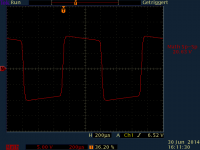 GoldenSample20140630_gain_min_reverb_min_vol_max_input_20mvrms_ch1_speaker_out.png6.3 KB · Views: 63
GoldenSample20140630_gain_min_reverb_min_vol_max_input_20mvrms_ch1_speaker_out.png6.3 KB · Views: 63 -
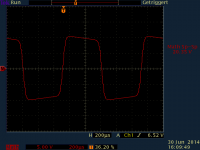 GoldenSample20140630_gain_min_reverb_min_vol_max_input_10mvrms_ch1_speaker_out.png6.5 KB · Views: 50
GoldenSample20140630_gain_min_reverb_min_vol_max_input_10mvrms_ch1_speaker_out.png6.5 KB · Views: 50 -
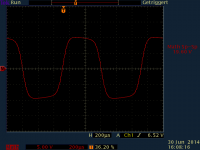 GoldenSample20140630_gain_min_reverb_min_vol_max_input_05mvrms_ch1_speaker_out.png6.7 KB · Views: 112
GoldenSample20140630_gain_min_reverb_min_vol_max_input_05mvrms_ch1_speaker_out.png6.7 KB · Views: 112 -
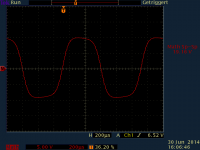 GoldenSample20140630_gain_min_reverb_min_vol_max_input_04mvrms_ch1_speaker_out.png6.8 KB · Views: 124
GoldenSample20140630_gain_min_reverb_min_vol_max_input_04mvrms_ch1_speaker_out.png6.8 KB · Views: 124 -
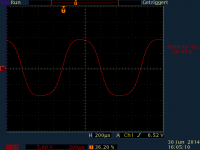 GoldenSample20140630_gain_min_reverb_min_vol_max_input_03mvrms_ch1_speaker_out.png6.8 KB · Views: 130
GoldenSample20140630_gain_min_reverb_min_vol_max_input_03mvrms_ch1_speaker_out.png6.8 KB · Views: 130 -
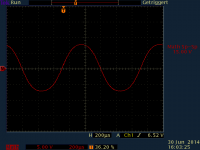 GoldenSample20140630_gain_min_reverb_min_vol_max_input_02mvrms_ch1_speaker_out.png6.8 KB · Views: 131
GoldenSample20140630_gain_min_reverb_min_vol_max_input_02mvrms_ch1_speaker_out.png6.8 KB · Views: 131
Pah! Those are sissy recommendations. 6V6s really shine at 400+ volts. And we need to remember, that dissipation is what really kills power tubes. I've also seen amps successfully running EL84s at 400+V, such as the Marshall 20/20 power amp.Yikes, 440 volts, that's pretty high, My Twin Reverb is 465v, AC mains 121v.
I really wish Fender would have stayed with the RCA tube manual recommendations for plate voltage on the 6V6, as they did in the tweed era.
Trinity's Triwatt is another example that runs 6V6s at 440V - with fixed bias, for around 20W "clean" output. With Trinity being located not too far away from me, in Ontario, I've had the pleasure I've trying a couple of these out. Some really smooth Hiwatt style clean tones, with great, fine-textured distortion, when cranked. I believe Trinity uses JJ 6V6s as standard, but other types have also been successfully used, including Sovteks and NOS RCAs. I haven't seen reports in online posts of any failures .
A little sound snippet of this TPA3118 amp, recorded from the PA - stereo-master mix during a gig last year.
The TPA3118 powered at 24V fired a Neodymium Celestion 12" century. I played my strat with some overdrive, added some Reverb (FX-1) and some Echo (PT2399) - no tubes inside
The TPA3118 powered at 24V fired a Neodymium Celestion 12" century. I played my strat with some overdrive, added some Reverb (FX-1) and some Echo (PT2399) - no tubes inside
Attachments
Way too much of a coincidence. I have a few 3118's that I plan on using for guitar, I was thinking of clipping the signal so the amp doesn't overload, I was thinking of picking up Neodymium Century at some point. What circuit are you using as a soft clipper? Sounds pretty good for a Strat, should be using a Tele though. 
How is the volume with the 3118 and the Century?
How is the volume with the 3118 and the Century?
- Status
- This old topic is closed. If you want to reopen this topic, contact a moderator using the "Report Post" button.
- Home
- Live Sound
- Instruments and Amps
- Tube Emulation & EQ
